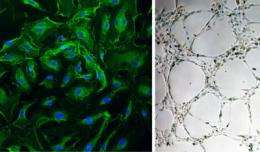Researchers identify molecule that increases blood flow in vascular disease

Circulating through the bloodstream of every human being is a rare and powerful type of cell, one that can actually create new blood vessels to bypass blockages that cause heart attacks and peripheral artery disease. Though everyone has these cells – called endothelial progenitor cells – they are often dysfunctional in people prone to vascular disease.
Now researchers at the University of North Carolina at Chapel Hill have discovered that a molecule – called Wnt1 – can improve the function of endothelial progenitor cells, increasing the blood flow to organs that previously had been cut off from the circulation. The finding could enhance clinical trials already testing these powerful cells in patients hospitalized with cardiac arrest.
"The premise of these trials is that these cells will supply the ischemic organ with new blood vessels and allow the damaged organ to function better," said senior study author Arjun Deb, MD, assistant professor of medicine in the UNC School of Medicine. "But because you are isolating these cells from the patients themselves, you know that the cells are dysfunctional -- so the approach is almost flawed from the very beginning. We want to see how we can improve the function of these cells so they can do their job better."
The study, published online Feb. 14, 2011, in the FASEB Journal, is the first to show that the Wnt1 protein, one of a family of 19 such molecules, can stimulate blood vessel formation.
A number of studies in the past few years have suggested that genes that play an important role during early development and get "turned off" during adulthood may also get "turned on" or expressed again in response to injury, such as heart attack.
Deb, who studies the Wnt family of developmental genes, looked to see if any of its members follow this same pattern. He found that one gene in particular, Wnt1, was expressed during development of blood vessels, shut off during adulthood and then re-expressed in angiosarcoma, a cancer of endothelial cells.
Deb wanted to see what would happen if he put the Wnt1 protein on human endothelial progenitor cells. He found that treating these special cells with Wnt1 not only greatly increased their function but also their number. Next, Deb and his colleagues investigated what effect the protein would have on a mouse model of peripheral artery disease, an illness in humans caused by decreased blood flow to the extremities. They found that treating these animals with a single injection of the Wnt1 protein resulted in almost three fold increase in blood flow in the affected areas.
"We found that Wnt1 is a novel proangiogenic molecule, something that has never been shown before," said Deb. "It gives us hope that injecting the Wnt1 protein -- or molecules that stimulate the Wnt1 signaling pathway -- into ischemic tissues in humans could improve blood flow and assert a therapeutic effect."
Approximately 1 in 4 deaths in adults in the US are secondary to heart disease and as many as 15 percent of Americans age 65 and older have peripheral artery disease. In the future, Deb plans to use his findings to identify such small molecules or drug candidates that could reverse the endothelial progenitor cell dysfunction observed in so many patients with vascular disease.















